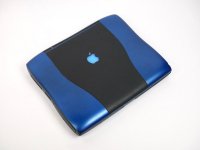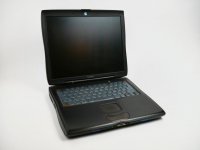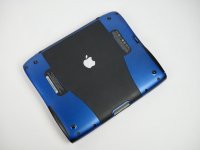Mighty Jabba
Well-known member
As projects go this one wasn't very hard at all -- I finished everything in a couple of hours. But I've had this Pismo PowerBook since it was new, and I used it a lot even after I had moved on to a 12" PowerBook G4 as my main machine, so it was very good to see it come back to life. I think this was originally a 400Mhz G3, but I later upgraded it to a 500Mhz G4. It has 512MB of RAM. As you can see, I did some modifications back in 2001, painting it, changing the color of the Apple logo, and adding a blank blue keyboard.
The first thing I had to do was order a new power adapter, since I couldn't find mine. Most of the ones on eBay seem to be for the later PowerBook G4/iBook generation and won't work with these, so this was a bit trickier than I thought. Once I had power, I found that the spinning hard disk had died and was making some very ominous clicks. So I replaced it with an SD card in an adapter (these would have been great to have back in the day, at least if we could have also had cheap large-capacity SD cards). I partitioned it and installed OS 9 and OS X Tiger (using XpostFacto). I still need to figure out a good solution for Wi-Fi, since none of my older machines seem to be able to connect to my Wi-Fi router due to them not supporting newer types of encryption. What do people typically do about this?



The first thing I had to do was order a new power adapter, since I couldn't find mine. Most of the ones on eBay seem to be for the later PowerBook G4/iBook generation and won't work with these, so this was a bit trickier than I thought. Once I had power, I found that the spinning hard disk had died and was making some very ominous clicks. So I replaced it with an SD card in an adapter (these would have been great to have back in the day, at least if we could have also had cheap large-capacity SD cards). I partitioned it and installed OS 9 and OS X Tiger (using XpostFacto). I still need to figure out a good solution for Wi-Fi, since none of my older machines seem to be able to connect to my Wi-Fi router due to them not supporting newer types of encryption. What do people typically do about this?



